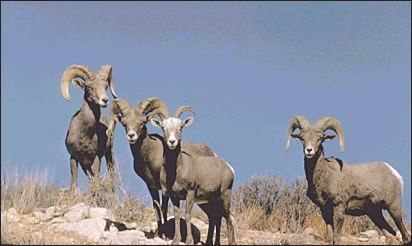

Few species of North American large herbivores survived the extinctions at the end of the Pleistocene some 11,000 years ago, and those of the Chihuahuan Desert region were even fewer: White-tailed Deer, Mule Deer, Elk, Pronghorn, Javelina, and Mountain Sheep. Elk, limited to highlands, were wiped out by over-hunting in historic times, though now reintroduced into the Guadalupe Mountains.
Mountain Sheep, often called Desert Bighorn in our area, barely hang on
in a few places of the Southwest and northernmost Mexico. Over-hunting in past times,
loss of habitat, and contraction of diseases from domestic sheep have combined to
threaten their very existence. Desert Bighorns are reliant on water sources and rough
terrain. As springs were fenced off or depleted by unwise land usage, flocks dwindled
and disappeared, until today the San Andres and Big Hatchet mountains support the few
surviving sheep. Introductions into the Big Bend, however, may yet provide a haven for
these symbols of desert mountains.

Contributor: Arthur H. Harris, Laboratory for Environmental Biology, Centennial Museum, University of Texas at El Paso.
Desert Diary is a joint production of the Centennial Museum and KTEP National Public Radio at the University of Texas at El Paso.

Bighorn Sheep (Ovis canadensis). Photograph by Glenn Vargas, California Academy of Sciences.